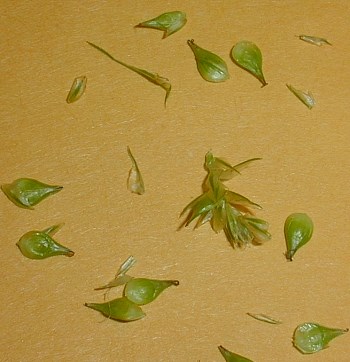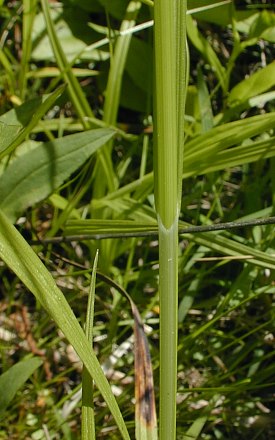Description: This perennial sedge produces culms about 2-3' tall and it is often tufted at the base with the leaves of low vegetative shoots. Each culm is light green, 3-angled, and rough underneath the inflorescence near the apex. There are 3-7 alternate leaves along the length of each culm; these leaves are located along the lower half of its length and they are ascending to widely spreading. The leaf blades are up to 5 mm. across and 1½' long; they are light to medium green, glabrous, and indented along their central veins. The side of each leaf sheath that is opposite from the blade is white and membranous; otherwise, the leaf sheaths are light green, glabrous, and finely veined. Sometimes the membranous side of a sheath is transversely puckered. The upper mouth of each sheath is usually concave, although some of the lower sheaths may be torn at the mouth and irregular in shape. At the junction of each blade and sheath, the ligule is about as long as wide.

Each culm terminates in a spike-like inflorescence about ¾–2" long. This inflorescence consists of about 5-10 sessile spikelets that are spaced only a short distance from each other along the culm. Each spikelet consists of a dense cluster of 10-15 perigynia and pistillate scales; there are also some staminate florets and their scales toward the apex of each spikelet. Each perigynium is about 4 mm. long and 2.5 mm. across; it is ovoid and flattened (more specifically, plano-convex). The perigynium tapers to a narrow beak at the apex, while at the bottom it is well-rounded. An immature perigynium is mostly light to medium green, although its becomes pale green to nearly white at the bottom. The outer surface of each perigynium has faint longitudinal nerves, while the inner surface is nerveless; its margins are not winged. Each pistillate scale is about 3 mm. long and lanceolate-ovate to ovate in shape with a green central vein; otherwise, it is membranous and transparent. The tip of each pistillate scale is more or less acutely pointed. The blooming period occurs from late spring to mid-summer. The florets rely on the wind for cross-pollination. The achenes are up to 1 mm. long, flattened, and ovoid-globoid in shape; they are slightly pointed at their tips. The root system is fibrous and short-rhizomatous.

Cultivation:
This
sedge prefers partial or dappled sunlight and a fertile loamy soil that
is consistently moist. It will also adapt to minor variations of the
preceding conditions.
Range & Habitat:
Clustered Sedge is occasional in central and northern Illinois, but
largely absent from the southern section of the state (see Distribution
Map). Because this sedge can be confused with similar
species, it may be more common than official records indicate. Habitats
include floodplain forests, woodland openings, wooded slopes and
ravines, moist meadows in wooded areas, powerline clearances in wooded
areas, and edges of streams in partially shaded areas.
Faunal Associations:
Many kinds of insects feed on Carex spp. (Sedges).
These include leafhoppers (especially Cosmotettix spp.),
slant-faced sedge grasshoppers (Stethophyma spp.),
various leaf beetles (Donacia porosicollis, Poecilocera
harrisii, several Plateumaris spp.), and
the caterpillars of many butterflies, skippers, and moths (see Lepidoptera
Table). The seeds or seedheads of Carex spp.
are an important source of food to many waterfowl, upland gamebirds,
and granivorous songbirds (see Bird Table). In contrast,
White-Tailed Deer rarely browse on most sedges, preferring broad-leaved
forbs.

Photographic Location:
A powerline clearance at Busey Woods in Urbana, Illinois.
Comments:
Some authorities have classified this sedge as a variety of Carex
sparganioides (Bur-Reed Sedge); the latter has wider leaves
(up to 10 mm. across) and a longer inflorescence (up to 6" in length).
The spikelets of Bur-Reed Sedge are more widely spaced from each other
than those of Clustered Sedge. Other similar species include Carex
gravida (Heavy Sedge) and Carex cephaloidea
(Rough Clustered Sedge). Heavy Sedge is primarily a prairie species
that has perigynia with shorter beaks and pistillate scales that are
about the same length as their perigynia; the leaves of this species
tend to be wider as well (up to 8 mm. across). Rough Clustered Sedge is
even more similar in appearance; like Clustered Sedge, it has been
classified as variety of Bur-Reed Sedge by some authorities. Rough
Clustered Sedge has wider leaves (up to 8 mm. across), culms that are
rough-textured throughout, sheaths with truncated mouths, and perigynia
with slightly winged margins. In contrast, Clustered Sedge has more
narrow leaves (6 mm. across or less), culms that are rough only
underneath the inflorescence, sheaths with concave mouths, and
perigynia that lack winged margins. Except for the long inflorescence
of the Bur-Reed Sedge, all of these sedges have a rather ordinary
appearance.